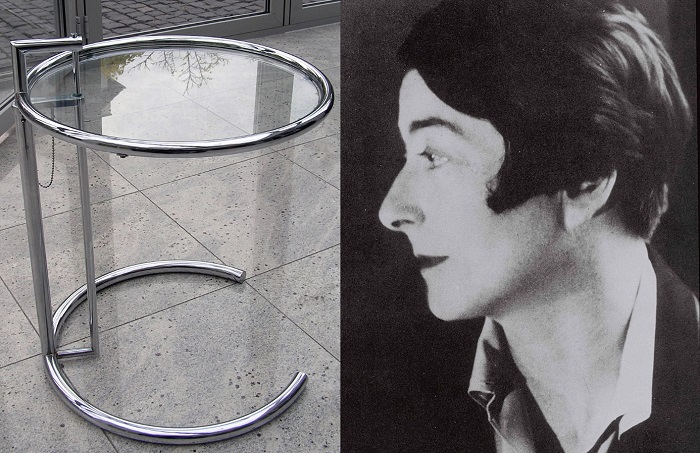ISABEL RUBIO ARROYO | Tungsteno
In 2009, the famous auction house Christie's sold a chair for 22 million euros, the highest price ever paid at auction for a piece of 20th century furniture. This record price was another vindication of the brilliant and neglected figure of Irishwoman Eileen Gray, who in addition to designing some of the most expensive and iconic furniture of the 20th century also created buildings such as the seaside villa E-1027, considered a landmark of modern architecture. To mark International Women's Day on 8 March, we examine the life and work of this architect and designer who was forced to carve out a niche for herself in a very male-dominated industry.
A table for eating breakfast in bed and other iconic pieces of furniture
Born into an aristocratic Irish family in 1878, Gray inherited her mother's interest in decoration. She was one of the first women admitted to the Slade School of Fine Art in London. During visits to the Victoria and Albert Museum, she became acquainted with Japanese and East Asian lacquerware. The sap of the lacquer tree, native to Japan, was used to cover and decorate a variety of objects and pieces of furniture. Lacquering is an extremely complex technique that requires humid conditions and the absence of dust. While Japanese craftspeople used to make their lacquerware at sea because of the importance of humidity in the process, Gray opted to work in her own bathroom. By the early 1920s, she had established herself as one of the leading designers of lacquered furniture in Paris.
As well as pioneering interior partitioning—for example, with screens or using shelving as architectural elements—she created some of the most memorable furniture of the contemporary period. Notable among them is the E1027 table, which is made of glass and tubular steel and allows the user to easily adjust the height. In this way, according to Gray, anyone could breakfast in bed without leaving crumbs on the sheets. Another classic design of the 20th century is the Bibendum chair, a voluptuous armchair with a tubular steel frame whose design is influenced by the Michelin Man, the mascot of the Michelin tyre company. Her furniture still attracts great interest at multimillion-dollar auctions and is sold in many luxury shops.

Irish-born Eileen Gray designed some of the most iconic furniture of the 20th century. Credit: Aram Designs.
A cliff-edge retreat
After opening a furniture shop, Gray began to turn to architecture as an escape. From drawing plans to distract herself, she went on to build her first and best-known building: Villa E-1027. This was a summer residence on a hill overlooking the Mediterranean in the French town of Roquebrune-Cap-Martin, which she intended to share with her lover, the Romanian architect Jean Badovici.
The name of this building, completed in 1929 and a symbol of modern architecture, is a coded message. While the "E" stands for Eileen, the numbers "10", "2" and "7" refer to the alphabetical order of the letters J, B and G—the initials of Jean, Badovici and Gray. In the home, the architect combined movable partitions with fixed walls and opted for adjustable and reclining furniture. This commitment to the creation of spaces that could be adapted to the needs of each person was unprecedented.
Le Corbusier, who claimed to admire Gray's work, frequented Villa E-1027. But supposedly the famous Swiss architect was annoyed that a woman could have executed such a remarkable construction in a style he considered his own. So in 1939, a nude Le Corbusier painted the walls of the villa with striking cubist murals, against the wishes of Gray herself, who, on learning of this, was thoroughly displeased. "I admit the mural is not to enhance the wall, but on the contrary, a means to violently destroy it," Le Corbusier later confessed. Years later, the house was abandoned and occupied by squatters several times. It has recently been restored and can now be visited.
Gray designed Villa E-1027, considered a landmark of modern architecture. Credit: Gold Creative.
An artist relegated to the background
In addition to this structure, Gray completed two more houses—the villas Tempe à Pailla and Lou Pérou—and designed nearly 50 architectural projects that were never built. "Space itself is for Eileen Gray just another material that can be transformed and molded depending on the needs of the décor; she allows herself an infinite number of possibilities," wrote Badovici. For all her contributions, Gray went unnoticed for decades. The architect was uncomfortable with self-promotion and largely refrained from publishing the kind of manifestos that cemented the reputation of many male architects. "I was not a pusher and maybe that's the reason I did not get the place I should have had," Gray herself said.
It was not until she was 94 that art historian Joseph Rykwert took notice of her work. The architect died in Paris in 1976 at the age of 98. Today, as Zeev Aram, chairman of the furniture design company Aram Designs, points out, her designs "are now as familiar as designs from the other important early 20th century architects and designers such as Le Corbusier, Mies van der Rohe, Marcel Breuer et al." While her furniture sells for millions of euros at auction, her work is a source of inspiration for designers and architects all over the world.
· — —
Tungsteno is a journalism laboratory to scan the essence of innovation. Devised by Materia Publicaciones Científicas for Sacyr’s blog.
